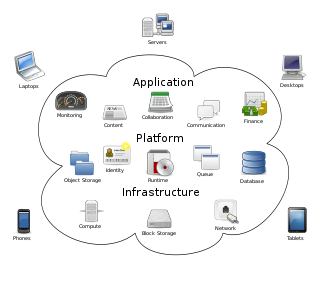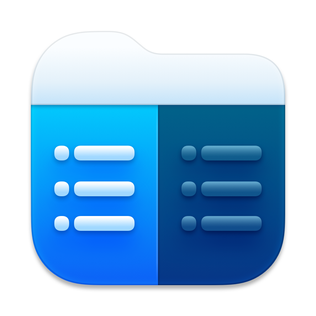Related Research Articles
The Secure Shell Protocol is a cryptographic network protocol for operating network services securely over an unsecured network. Its most notable applications are remote login and command-line execution.
The File Transfer Protocol (FTP) is a standard communication protocol used for the transfer of computer files from a server to a client on a computer network. FTP is built on a client–server model architecture using separate control and data connections between the client and the server. FTP users may authenticate themselves with a plain-text sign-in protocol, normally in the form of a username and password, but can connect anonymously if the server is configured to allow it. For secure transmission that protects the username and password, and encrypts the content, FTP is often secured with SSL/TLS (FTPS) or replaced with SSH File Transfer Protocol (SFTP).
In computing, the SSH File Transfer Protocol, also known as Secure File Transfer Protocol (SFTP), is a network protocol that provides file access, file transfer, and file management over any reliable data stream. It was designed by the Internet Engineering Task Force (IETF) as an extension of the Secure Shell protocol (SSH) version 2.0 to provide secure file transfer capabilities, and is seen as a replacement of File Transfer Protocol (FTP) due to superior security. The IETF Internet Draft states that, even though this protocol is described in the context of the SSH-2 protocol, it could be used in a number of different applications, such as secure file transfer over Transport Layer Security (TLS) and transfer of management information in VPN applications.

Network-attached storage (NAS) is a file-level computer data storage server connected to a computer network providing data access to a heterogeneous group of clients. The term "NAS" can refer to both the technology and systems involved, or a specialized device built for such functionality.
Secure copy protocol (SCP) is a means of securely transferring computer files between a local host and a remote host or between two remote hosts. It is based on the Secure Shell (SSH) protocol. "SCP" commonly refers to both the Secure Copy Protocol and the program itself.
File eXchange Protocol is a method of data transfer which uses FTP to transfer data from one remote server to another (inter-server) without routing this data through the client's connection. Conventional FTP involves a single server and a single client; all data transmission is done between these two. In the FXP session, a client maintains a standard FTP connection to two servers, and can direct either server to connect to the other to initiate a data transfer. The advantage of using FXP over FTP is evident when a high-bandwidth server demands resources from another high-bandwidth server, but only a low-bandwidth client, such as a network administrator working away from location, has the authority to access the resources on both servers.

FileZilla is a free and open-source, cross-platform FTP application, consisting of FileZilla Client and FileZilla Server. Clients are available for Windows, Linux, and macOS. Both server and client support FTP and FTPS, while the client can in addition connect to SFTP servers. FileZilla's source code is hosted on SourceForge.
FTPS is an extension to the commonly used File Transfer Protocol (FTP) that adds support for the Transport Layer Security (TLS) and, formerly, the Secure Sockets Layer cryptographic protocols.
Workspace is a term used in various branches of engineering and economic development.
This article lists communication protocols that are designed for file transfer over a telecommunications network.

WinSCP is a file manager, SSH File Transfer Protocol (SFTP), File Transfer Protocol (FTP), WebDAV, Amazon S3, and secure copy protocol (SCP) client for Microsoft Windows. The WinSCP project has released its source code on GitHub under an open source license, while the program itself is distributed as proprietary freeware.
CrushFTP is a proprietary multi-protocol, multi-platform file transfer server originally developed in 1999. CrushFTP is shareware with a tiered pricing model. It is targeted at home users on up to enterprise users.

Cloud computing is "a paradigm for enabling network access to a scalable and elastic pool of shareable physical or virtual resources with self-service provisioning and administration on-demand," according to ISO.

Linoma Software was a developer of secure managed file transfer and IBM i software solutions. The company was acquired by HelpSystems in June 2016. Mid-sized companies, large enterprises and government entities use Linoma's software products to protect sensitive data and comply with data security regulations such as PCI DSS, HIPAA/HITECH, SOX, GLBA and state privacy laws. Linoma's software runs on a variety of platforms including Windows, Linux, UNIX, IBM i, AIX, Solaris, HP-UX and Mac OS X.
GlobalScape, Inc. (AMEX:GSB) is a software developer headquartered in San Antonio, Texas, US.
PeSIT is a file transfer protocol developed in 1986 by the French Interbank Teleclearing System Economic Interest Grouping. Designed by working groups of file transfer experts from large computing centers, it offers basic file transfer functionalities and advanced features for managing mass file transfers and organizing industrial-scale file transfer services. PeSIT connections occur between two named and identifiable partners. The initiator of a connection, acting as the PeSIT requester, negotiates with the PeSIT responder for sending or receiving a file, sending a message, or acknowledging a transfer. The negotiation for file transfer does not involve mentioning the file name or its location in the partners' file systems (FS) but rather a virtual file identified by an identifier, "filename," which corresponds to local sets of definitions for accessing and reading a file on the sender's side and creating and writing it on the receiver's side. Each transfer has a unique identification known by both exchange partners. The protocol allows assigning a priority to each transfer, which should be respected by both parties.

Commander One is a dual-pane file manager designed for macOS. Developed by Electronic Team, Inc., the software is created entirely in Swift and aims to provide users with a tool to navigate, manage, and manipulate files and folders on their Mac computers. The application offers a wide range of features for both casual and professional users.
A Software-Defined Wide Area Network (SD-WAN) is a wide area network that uses software-defined networking technology, such as communicating over the Internet using overlay tunnels which are encrypted when destined for internal organization locations.
Enterprise file synchronization and sharing refers to software services that enable organizations to securely synchronize and share documents, photos, videos and files from multiple devices with employees, and external customers and partners. Organizations often adopt these technologies to prevent employees from using consumer-based file sharing apps to store, access and manage corporate data that is outside of the IT department's control and visibility.
Sniffing attack in context of network security, corresponds to theft or interception of data by capturing the network traffic using a packet sniffer. When data is transmitted across networks, if the data packets are not encrypted, the data within the network packet can be read using a sniffer. Using a sniffer application, an attacker can analyze the network and gain information to eventually cause the network to crash or to become corrupted, or read the communications happening across the network.
References
- ↑ "Definition of Managed File Transfer (MFT) - Gartner Information Technology Glossary". Gartner. Retrieved 24 May 2021.
- ↑ "Market Snapshot: Managed File Transfer, Worldwide, 2020". Gartner. 21 January 2021.[ dead link ]
- 1 2 "Definition of Managed File Transfer (MFT) - Gartner Information Technology Glossary". Gartner. Retrieved 4 March 2021.
- ↑ "Best Managed File Transfer (MFT) Software". G2. Retrieved 24 May 2021.
- ↑ "Global Managed File Transfer Market Trajectory & Analytics Report 2021: Market to Reach $2.4 Billion by 2027 - Application-Centric Segment to Account for $1.1 Billion - ResearchAndMarkets.com". finance.yahoo.com. Retrieved 24 May 2021.
- ↑ "Category: Managed File Transfer (MFT)". G2. Retrieved 4 March 2021.
- ↑ "6 Ways FTP/SFTP is Putting Your Business at Risk". IBM. Retrieved 5 February 2024.